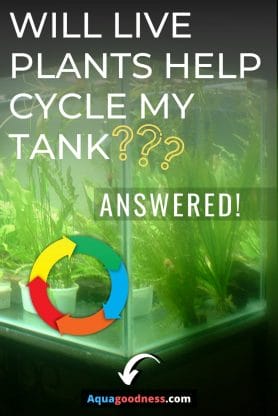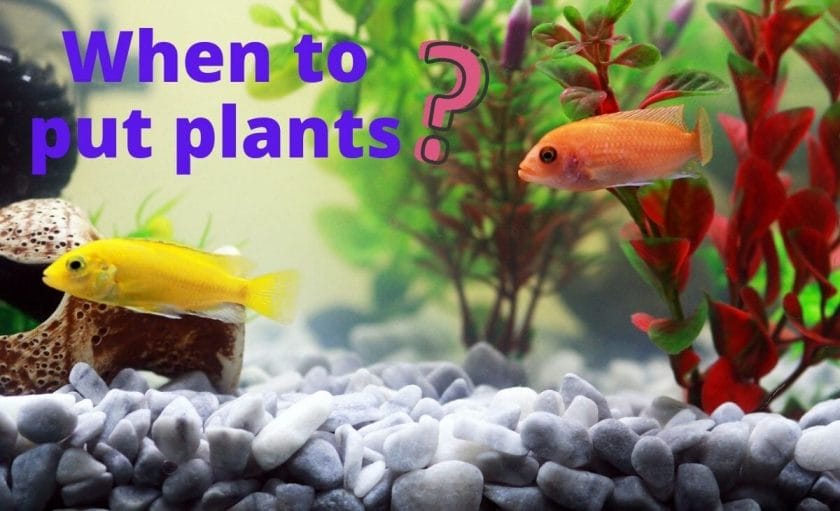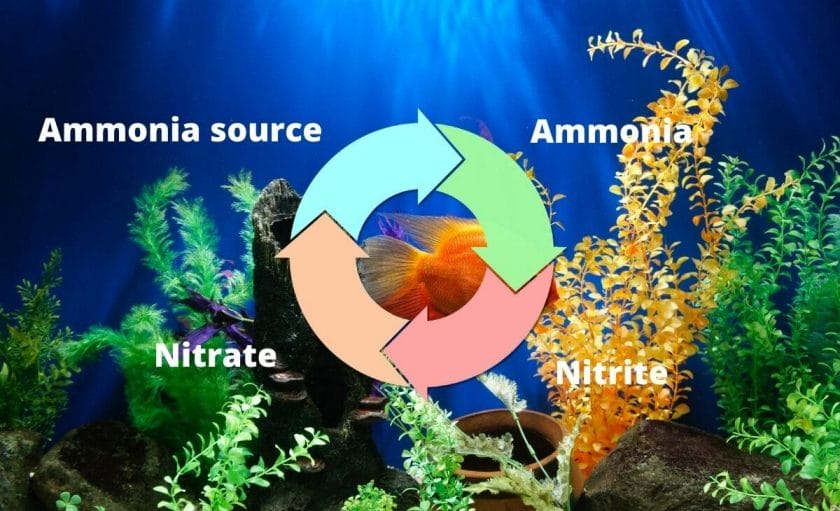If you are wondering, will live plants help cycle your fish tank then you are in the right place.
In this article, I am going to answer the same question.
Live plants help to cycle a fish tank by absorbing ammonia, nitrite, and nitrate. Also, live plants increase oxygen in a fish tank which helps to increase the beneficial bacteria which is responsible to cycle a fish tank.

Table of Contents
How do live plants help to cycle a fish tank?
In several ways live plants help to speed-up the cycling process of your fish tank.
Live plants can even instantly cycle your fish tank!
1. Live plants absorb ammonia, nitrite, and nitrate
The ammonia, nitrite, and nitrate present in your fish tank are harmful to the fish in your aquarium.
However, these products are actually useful for the plants.
Live aquarium plants use ammonia, nitrite, and nitrate as fertilizers. And it helps them to grow faster and better.
So when you put live aquarium plants in your fish tank while cycling the tank, the live plants will absorb ammonia, nitrite, and nitrate which will speed up the nitrogen cycle process.
It can reduce the time it may have generally took to complete the nitrogen cycle.
How much time it can reduce really depends on what type of plants you plant in your fish tank. And the number of plants you plant in your fish tank.
Basically, if you plant fast growing plants and a lot of plants in your tank then it can significantly speed up the nitrogen cycle process.
What Happens if You Don’t Cycle a Fish Tank? (Is It Really Necessary)
2. Live aquarium plants increase oxygen in a fish tank
Just like the plants on the land, live aquarium plants release oxygen during the day or when the light is on in the fish tank.
This increases the oxygen level in the fish tank.
The beneficial bacteria that is responsible to complete the nitrogen cycle needs oxygen.
And when there is a lot of oxygen in a fish tank, the beneficial bacteria grow rapidly in the tank which helps to speed up the nitrogen cycle process.
Should I Do a Water Change During Fishless Cycling?
3. Live aquarium plants provide surfaces for the beneficial bacteria
The beneficial bacteria which is responsible for completing the nitrogen cycle need surface to form their colonies.
And the leaves and stem of the live aquarium plants are a very good place for the beneficial bacteria to form their colonies.
And, in theory, the more beneficial bacteria you have in your fish tank, the faster your fish tank cycle will be and the sooner your fish tank cycle will be completed.
How Long Does It Take To Cycle A Fish Tank? (Without And With Fish)
4. Live aquarium plants add beneficial bacteria in your fish tank
Before you put the live aquarium plants in your fish tank there is a possibility that the plants are grown in a fish tank.
And probably the fish tank where the plants are grown are established.
So, as I mentioned earlier, live plants provide very good surfaces for beneficial bacteria to form their colonies.
And when you get live plants from an established tank and put it in your new tank you are essentially not only adding the live plants but also adding some beneficial bacteria deposited on the plant in your fish tank.
This helps to kickstart your fish tank cycle!
Can I Use Fish Food to Cycle My Tank?
5. Live plans are a lifesaver (literally) especially if you are doing fish-in cycling
In the fish-in cycling method, you add the fish in the fish tank from the very beginning even before cycling your fish tank.
Then you feed the fish. Then fish produce waste in the fish tank.
After some time, the fish waste gets converted into ammonia which is toxic for the fish.
Even a slight ammonia level stresses the fish. And it reduces the life expectancy of the fish. In the worst case, it can even kill the fish.
That’s why if you add the live aquarium plants in your fish tank when you are doing fish-in cycling the plants will absorb ammonia from the fish tank. And this can save the life of your fish.
Tip: If you are considering fish-in cycling then, in the beginning, you should stock your fish tank very lightly. I would recommend you to start with a couple of small fish. Then as the beneficial bacteria started to grow in your fish tank then you can add more fish into the tank.
When to put live aquarium plants for cycling a fish tank?

Ideally, you should put the live aquarium plants at the very beginning even before your fish tank cycle is started.
There are actually a couple of benefits of planting the live aquarium plants at the very beginning.
1. Easy to plant
It is very easy to plant the live aquarium plants in a fish tank at the very beginning.
Just add the substrate of your choice in the fish tank. And then plant the live plants using tweezers or by simply making a hole in the substrate and putting the plant into the hole and covering its roots.
If you have already filled up your fish tank then you can remove about 50% of the water from your fish tank and then plant the plants.
Do I Need Soil for Aquarium Plants?
2. Plants helps to speed up fish tank cycling
As we discussed above, live aquarium plants help to speed up the fish tank cycling process.
So it is a good idea to plant the live aquarium plants at the very beginning of your fish tank to reduce some time to complete the nitrogen cycle process.
Caution: When you plant the live aquarium plants in the very beginning in your fish tank, you should not supplement the plant plants with any fertilizers. Because this can cause algae bloom in your fish tank.
You can start supplementing the plants with fertilizers once the fish tank is established i.e. when its nitrogen cycle is completed.
3 Best live aquarium plants to speed up your fish tank cycle

Now I am going to mention some easy to care live aquarium plants that you can put in your fish tank at the very beginning to speed up your fish tank cycle.
1. Anacharis
See more images at Amazon here
| PARAMETERS | VALUES |
|---|---|
| PLANT | Anacharis |
| SCIENTIFIC NAME | Elodea |
| FAMILY | Hydrocharitaceae |
| CARE LEVEL | Easy |
| LIGHT REQUIREMENT | Moderate |
| GROWTH RATE | Fast |
| TEMPERATURE | 60-82° F |
| pH | 6.5-7.5 |
| HARDNESS | KH 3-8 |
| PLACEMENT | Background |
| MAXIMUM SIZE | 6 to 8 inches |
| MINIMUM TANK SIZE | 10 gallon |
Anacharis is also known by different names such as Brazilian elodea, Brazilian waterweed, and Egaria.
This plant can tolerate a wide range of water parameters that’s why it is one of the best plants for beginners. And is it is very easy to care for so you can put it in any aquarium whether you are building a cold water aquarium or a tropical aquarium.
Lighting requirements for anacharis
Anacharis is not a very light-demanding plant.
However, you should provide it at least 2 watts of light per gallon.
If you provide less than that then the plant will die.
On the other hand, if you provide it too much light then this can lead to algae bloom in your fish tank.
The best place to keep Anacharis in your fish tank
The best part about Anacharis is that it doesn’t really need any substrate to put in your aquarium.
You can either attach it to any ornament like driftwood or rock and put it in your aquarium. Or you can just let it float in your aquarium.
Also, you can plant anchor it into the substrate.
Substrate requirements for anacharis
Anacharis doesn’t require a special substrate or for that matter any substrate to put in your fish tank.
However, anacharis does absorb nutrients through its roots. So if you plant it in a nutrient-rich substrate then it will definitely benefit from it. And grow faster and better in your fish tank.
Fertilization requirements for anacharis
Anacharis is a pretty Hardy plant and it can do well without any additional fertilizers.
At the beginning of your fish tank i.e. during the cycling process, you should not supplement the plants with any fertilizers anyways.
Once your fish tank is established then you can consider supplementing anacharis with some fertilizers and even CO2 for explosive growth.
Check the price of this plant at Amazon here
2. Hornwort
See more images at Amazon here
| PARAMETERS | VALUES |
|---|---|
| PLANT | Hornwort |
| SCIENTIFIC NAME | Anthocerotophyta |
| CARE LEVEL | Easy |
| LIGHT REQUIREMENT | Medium |
| GROWTH RATE | Fast |
| TEMPERATURE | 59-86°F |
| pH | 6.0-7.5 |
| HARDNESS | 5-15 dGH |
| PLACEMENT | Background |
| MAXIMUM SIZE | 10 foot |
| MINIMUM TANK SIZE | 15 gallons |
Hornwort is one of the more popular aquarium plants.
This plant can tolerate a wide range of water parameters which makes it ideal for beginners.
And you can keep this plant in any aquarium whether that is a cold water aquarium or a tropical aquarium.
This plant grows pretty fast. So it draws a lot of nutrients like ammonia, nitrite, and nitrate through the water for its growth.
That’s why it is an ideal plant for speeding up the cycling process.
Lighting requirements for Hornwort
Hornwort is a fast growing plant. And it absorbs a lot of nutrients through the water column.
However, to take advantage of all the nutrients and grow faster, you will need to provide high-intensity light to Hornwort.
In your aquarium, make sure that the plant is not in a shaded part. And it is receiving direct light.
Substrate requirements for hornwort
Hornwort doesn’t have any real roots.
So you don’t need to plant it in the substrate of your fish tank.
However, if you want to plant it in the substrate of your fish tank then you can use its bottom leaves to anchor it in the substrate.
As it is a tall and fast growing plant you should keep it in the background of your tank.
Besides, you can also attach it to any ornament like driftwood or rock in your fish tank. And you can also leave it floating in your fish tank.
Fertilization requirements for hornwort
The good part about hornwort is that it is always hungry for nutrients like ammonia, nitrite, and nitrates.
That’s why it is one of the best plants to keep in your fish tank to speed up the nitrogen cycle process.
It will suck up a lot of ammonia, nitrite, and nitrate from your fish tank. And this will reduce the time to complete the nitrogen cycle.
Once your fish tank is established you may need to supplement hornwort with additional fertilizers so that it can keep up with its growth.
And most importantly, if you have other plants in your tank, it is very important to supplement the plants with fertilizers once your tank is established. So other plants can also get nutrients.
Check the price of this plant at Amazon here
3. Pothos plant
See more images at Amazon here
| PARAMETERS | VALUES |
|---|---|
| PLANT | Pothos |
| COMMON NAMES | Golden pothos, silver vine, taro vine, devil's vine, devil's ivy |
| SCIENTIFIC NAME | Epipremnum aureum |
| FAMILY | Araceae |
| CARE LEVEL | Easy |
| LIGHT REQUIREMENT | Low to high |
| GROWTH RATE | Fast |
| PLACEMENT | Hanging out site the aquarium |
| MAXIMUM SIZE | 6 to 30 feet |
Pothos plant is actually not an aquarium plant.
It is a house plant.
But I am going to mention it here anyway because it is one of the best plants to absorb ammonia out of the fish tank.
And it is the hardiest plant to grow. And it doesn’t require any care.
You just have to put the roots of the plant into your fish tank. And all the other parts hanging outside your fish tank and that’s it. It will take care of itself and grow.
It will suck up a lot of ammonia, nitrite, and nitrate from the fish tank and will help to speed up your nitrogen cycle.
Lighting requirements for pothos
Pothos is not a very light-demanding plant.
However, for its faster growth, you should keep it in a well-lit area.
Substrate requirements for pothos plant
You don’t need any substrate to plant the pothos plant in your aquarium.
You just need to put the roots of the plant into your fish tank and all the other parts hanging outside the tank.
Fertilization requirements
You don’t need to fertilize pothos plant.
You can remove the plant once the nitrogen cycle process is completed if you want.
But if you can you should keep it in your fish tank. Because it will help to keep your aquarium water clean for a long time by absorbing nitrates from your fish tank.
Besides, there are a lot of benefits of keeping pothos plant in house.
Check the price of this plant at Amazon here
How to plant live aquarium plants
There are several ways you can keep live aquarium plants in your fish tank.
And the way you plant them differs a bit depending on how you want to keep in in your tank.
So now I’m going to show you different ways to keep live aquarium plants in your tank and how to keep them.
6 Tips to Take Care of Live Plants in Aquarium (For Beginners)
How to plant live aquarium plant in substrate?
How to attach live aquarium plants to driftwood or rock?
How to keep pothos plant in an aquarium?
Is it possible to cycle a fish tank instantly using live aquarium plants only?
In theory, it is possible to instantly cycle your fish tank with live aquarium plants.
However, you will need to put a lot of live aquarium plants in your fish tank.
Because to cycle a fish tank instantly you want the plants in the tank to absorb all the ammonia produced by the fish in the tank.
Also, you will need to stock your fish tank very lightly at the beginning so the fish will not produce a lot of ammonia.
There are some people that are having success cycling their fish tank instantly using just live aquarium plants.
Like this guy mentions in this forum thread.
He has instantly recycled his 45-gallon fish tank.
However, he has planted his tank quite heavily.
These are the plants he put in his 45-gallon fish tank:
- 3 water Sprite
- 10corkscrew vallisneria
- 4 Java fern
- 4 anubias
- 1 sword plant
- Christmas moss
- Wisteria
- Hornwort
- Java moss
So as you can see these are quite a lot of plants for 45 gallon tank.
Also, he mentions that he stocked the fish tank very lightly at the beginning.
And then he increased his fish stock.
So overall, it is possible to cycle your fish tank instantly using live aquarium plants only.
However, you will need to put a lot of live aquarium plants in your tank. And initially, you will need to stock your fish tank very lightly.
What Is The Fastest Way To Cycle A Freshwater Fish Tank?
Conclusion
Live aquarium plants can help to speed up the cycling process of your fish tank.
Besides, there are a lot of benefits of keeping live aquarium plants in a fish tank.
I hope you found this article helpful.
If you do, please share it.
Good luck with your nitrogen cycle!
Related articles:


